A Fast One for Pete
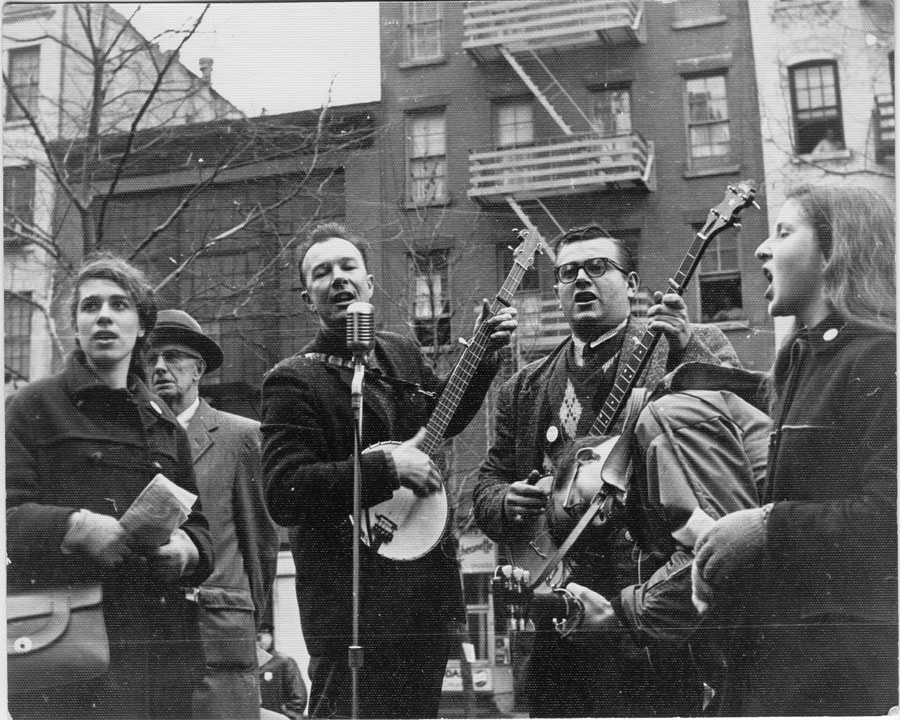 Pete Seeger performs at NY Sane Easter Rally, April 2, 1961
Pete Seeger performs at NY Sane Easter Rally, April 2, 1961
(Note: I’ve published an expanded version of this post as an essay on medium.com.)
I’m deep into a reporting project right now that doesn’t allow me to do as much as I’d like for Veterans Day with my father’s letters as a soldier serving in the Korean War. I did, however, unearth this gem of an anecdote about him and Pete Seeger and the Weavers, written to my mother on my father’s twenty-third birthday, while he was laid up in a military hospital in Fort Belvoir, Va.
Friday Dec 22, 1950
12 P.M.Dearest Esther,
It was good to hear your voice. I couldn’t say much as I was sort of choked up. This is a terrible way to spend your birthday. I miss you terribly.
It just started snowing here. It looks beautiful but I feel sorry for the kids who are in training.
I pulled a fast one on Wednesday. I went out of the hospital but I did not go out with the company for training. The officers were all away and I went to Washington and I saw Pete Seeger. He was wonderful to me. He took me to a steak lunch and I saw the show he and the Weavers are in. The other acts were pretty corny and vulgar but the Weavers are wonderful. Pete tells me that Irene is the second biggest selling record Decca Records has ever had. It has sold somewhere near 2 million copies. They have some new records coming out. So Long it’s been good to know you …, Lee’s song Lonesome Traveling, Fireship and John B Sails are the songs coming out. Pete says Fireship is awful but the others are pretty good. They expect Lonesome Traveling and So Long to be big hits. The whole Seeger family has moved to Pete’s house in Beacon. The MacDougal Street apt is boarded up and will be torn down. We are invited to spend a vacation there anytime we wish. Maybe when I get a furlough we will go for a few days. Pete has written me words to “We Wish You a Merry Christmas.” They are wonderful. In their dressing room the Weavers sung them for me. On the stage the group is wonderful. The audience loved them. They sang Tzena, Irene, John B, Lonesome Traveling, Hey Laili Laili … and a few others. They literally had the audience in cheers….
The snow has completely covered the ground. Outside everything looks clean and comfortable. Like clean sheets when you are tired. I find it difficult to concentrate on a letter. I think it is because I am doped up with medicine. Sometimes I feel like I am drunk. I guess there is some codeine in some of the pills I take. I hope they decide I do not have rheumatic fever. If I do it would probably mean several months in the hospital. That is something I do not look forward to. I have too much nervous energy to be able to be bed ridden that long. Besides it would preclude leaves home and that is a wretched thought. I think constantly of all the nice things we will be able to do when I can be home for a little while.
With all my love
Paul
I knew my father’s friendship with Pete Seeger dated back to the early 1960s with the civil rights and peace movements. The photo of Pete Seeger, above, for example, comes from an anti-nuclear march on the UN led by my father and Bayard Rustin on Easter 1961. At the time, my father was executive director of the Greater New York Council for a Sane Nuclear Policy. And I remember going with my father in the early 1980s to see Pete perform somewhere in the Albany, NY area, I think the Troy Savings Bank Music Hall. Afterwards Dad took me up front to meet Pete. But I did not know that the friendship with Pete dated back to 1950, such that Pete would be taking my father out to eat and then to hang out with the Weavers in their dressing room before a performance. It’s not entirely surprising, since Dad moved in bohemian artist, labor, socialist and communist circles in Greenwich Village and elsewhere in New York City since the mid 40s. But until I read this letter I had no information about the friendship with Pete Seeger in those years.
My father had planned, at first, to be a conscientious objector. On July 9, 1950, before my parents were married, he wrote to my mother:
You know that I couldn’t even think of going into the American army now. I would rather die than fight or even train to fight in this filthy business. I don’t know what the form of the draft is going to be or what the organized resistance is going to be like but as of know I think my own personal fight will be to refuse to register and as best possible let it be known publicly that I won’t fight a war for the protection of the right to exploit workers wether they be Korean or American.
But he did go on to train and fight just a couple months later. What changed his mind, I don’t yet know. Still other letters sent home from Korea and Japan show that he remained deeply troubled by the Korean War as he served his country. I think this is the Pete Seeger song Dad would say to play for Veterans Day.
November 10, 2013 letters photo dad pete seeger weavers esther novogrodsky army fort belvoir paul greenberg mom united nations un veterans day korean war decca records bayard rustin albany ny greenwich village japan where have all the flowers gone video youtube
Only to Greenberg
 Paul Greenberg, September 26, 1950, Fort Dix, NJ
Paul Greenberg, September 26, 1950, Fort Dix, NJ
My father enclosed this photo in a letter to my mother on September 26, 1950. Recently drafted, he was stationed at Fort Dix, NJ, where he was in basic training, soon to be shipped overseas to serve in Korea. They were not yet married, and my mother was living with her parents in Manhattan at 160 E 3rd Street, while attending Sarah Lawrence College. On the back of the photo, Dad scribbled, “Come out from behind those specs there.” The letter was handwritten. Here’s a transcription:
September 26, 1950
21:45 o’clockDear Esther,
I am sorry I didn’t write last night. I just felt too miserable and I didn’t want to transmit the misery to you. I feel much better now. My sense of humor has returned.
Only to Greenberg could it happen. The 68 men I am with are lost. That is our records are lost. They don’t know what to do with us. The rumors fly around like a swarm of late summer flies. Bzzz Bzzz Bzzz. I am afraid to have anyone visit me as I do not know where I will be. I hope tomorrow I can send you an address so that I can find out what you are doing regularly.
When you come don’t bring anything but food. Fresh fruit would be almost as welcome as yourself.
Little things have become so welcome. Tonight I had a tomato for the first time. Mmmm was it good. And tonight I had hot water for only the second time.
However I am able to laugh and enjoy something funny when it happens. I am getting a fabulous reputation about my appetite. I guess the continual fresh air goored [sic?] it up a bit. Anyway I get on the meal line 2 or 3 times and I am gaining wait. I’ll look health yet. Someday you will meet me and ask for Paul Greenberg.
I hope I can see you Sunday. I look at your picture all the time but that is a poor substitute for you.
Well I have to close now. The lights go out now and I have to lock up my stuff.
I love you
Paul
October 20, 2013 dad paul greenberg esther novogrodsky photo fort dix army letters
One Day before the March
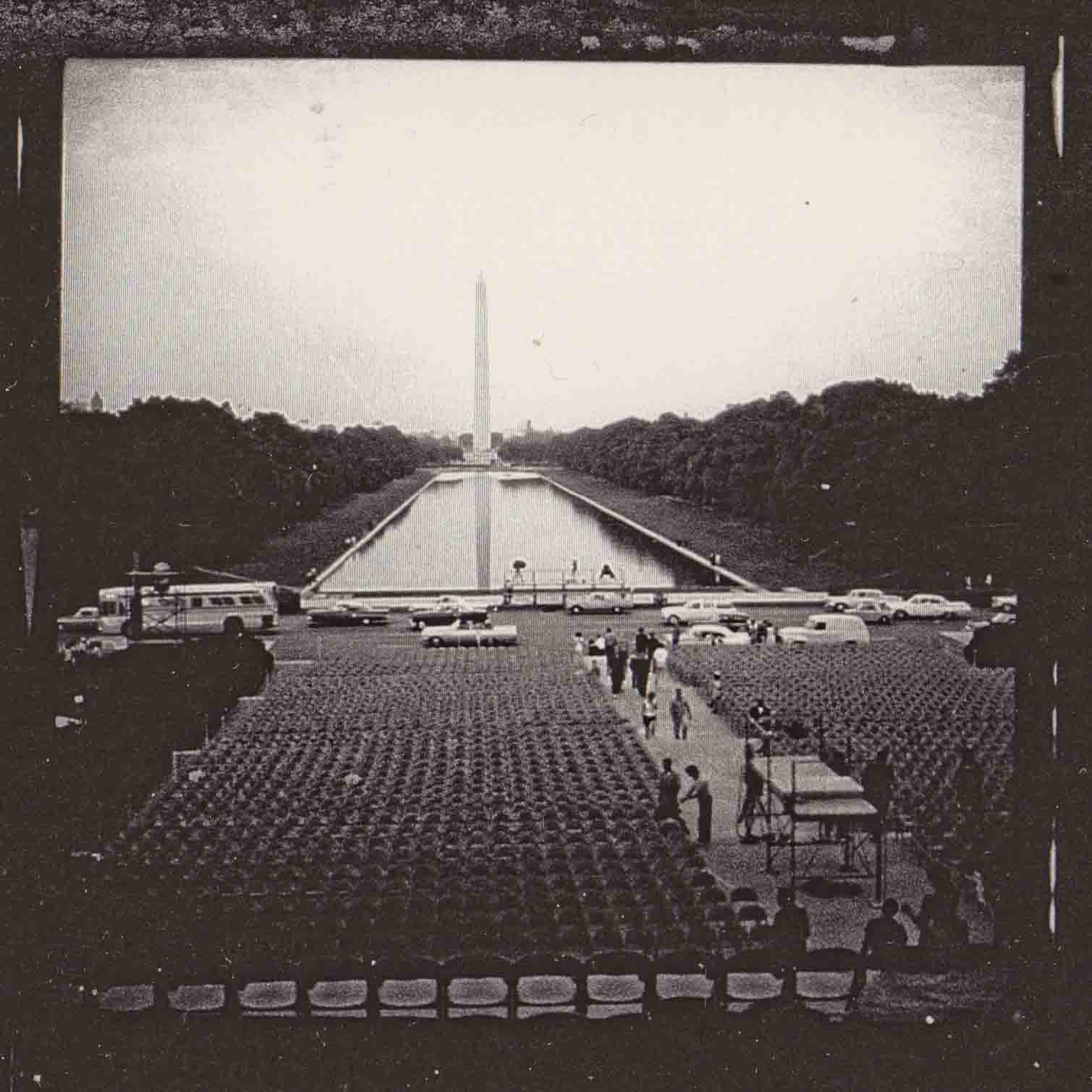 Seating for the March on Washington (Photo by Bob Adamenko)
Seating for the March on Washington (Photo by Bob Adamenko)
My father’s friend Bob Adamenko was on setup and security duty for the March on Washington in 1963. He took took this shot on August 27, 1963, from the Lincoln Memorial—showing the setting for the massive rally that was to occur there the next day.
I like looking at Bob’s photo next to this more familiar one, which is almost the same composition but with the marchers added.
 Washington marchers assembled for the rally at the Lincoln Memorial, August 28, 1963 (US Government photo)
Washington marchers assembled for the rally at the Lincoln Memorial, August 28, 1963 (US Government photo)
Bob’s photo is scanned from a contact sheet containing a half a dozen shots from DC, the day before the March. Bob sent the images to me in 2005, after he found my blog posts about Salute to Freedom Fundraiser, which my dad helped organize in Birmingham, AL to raise money to send locals to DC for the March.
“Ben, I came across Hungry Blues … on line and my past was coming out of my head, what a wonderful time I had with Paul in Birmingham,” Bob said in an email in October of 2004. “[Y]our dad was my mentor and friend.”
 AGVA Salute to Freedom flyer
AGVA Salute to Freedom flyer
Bob joined Dad there, for the concert in Birmingham, too—also to work security. Because Bob was there, I have this photo of Dad and James Baldwin at the AG Gaston Motel, where the participants gathered before the big concert, which featured Ray Charles, Johnny Mathis, Nina Simone, Ella Fitzgerald and others.
 James Baldwin and Paul Greenberg at the AG Gaston Motel, Birmingham, AL, August 4, 1963 (Photo by Bob Adamenko)
James Baldwin and Paul Greenberg at the AG Gaston Motel, Birmingham, AL, August 4, 1963 (Photo by Bob Adamenko)
I wasn’t able to reach Bob after I published this photo in an article in 2011, but as the 50th anniversary of the March on Washington has been approaching it seemed like a good time to try again.
In 2005 Bob had scrawled on the contact sheet with silver metallic sharpie: “March to Washington 1 day out - prep. I still haven’t found the rest of these negatives.” I thought, maybe he’s found the rest of the negatives in the time since. And maybe he can tell me some of the specific details of how he and my father were involved in the March. The photos and the memories would be precious.
My email to Bob bounced and his phone number was no longer active. I called a relative of Bob’s who had let me know when his wife passed away in 2007. Bob’s relative explained that Bob lives in a nursing home now and is not in good enough health to talk. She gave me a phone number for Bob’s son, who is around my age. I called and left a message on the answering machine.
Bob and my father teamed up on many adventures, partly through their mutual involvement in the Liberal Party of New York.
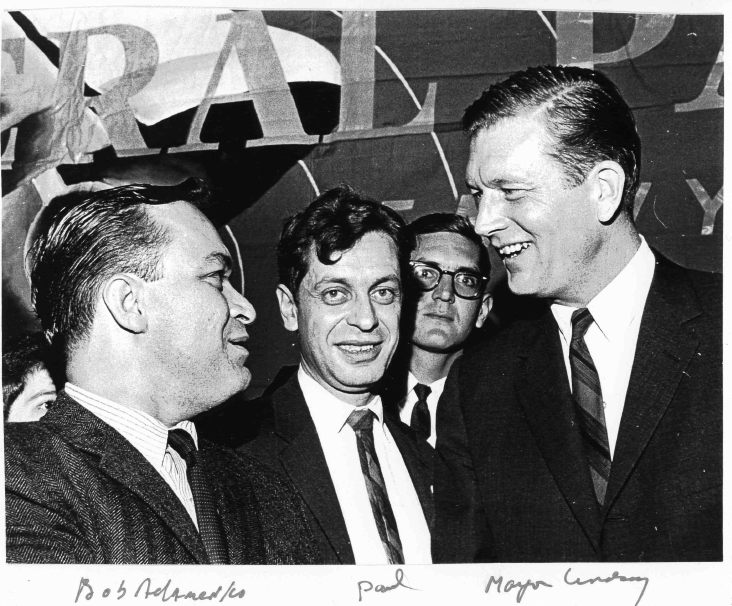 Bob Adamenko, Paul Greenberg, and John Lindsay in 1965, at Lindsay’s first public appearance after winning the mayoral election in NYC.
Bob Adamenko, Paul Greenberg, and John Lindsay in 1965, at Lindsay’s first public appearance after winning the mayoral election in NYC.
Back when my family lived in Teaneck, NJ, from about 1970 to 1975, we spent time with the Adamenkos, who lived nearby in Teaneck or Fort Lee. When I was a boy, Bob called me Ben Ben. I still remember his exuberance and warmth then and when he contacted me in 2004.
Missed opportunities like this one come with the territory of the historical journalism that I do. And they are always hard.
Maybe Bob’s kids have those negatives.
August 21, 2013 paul greenberg james baldwin march on washington liberal party of new york teaneck nj bob adamenko ag gaston motel birmingham al ray charles johnny mathis nina simone ella fitzgerald hungryblues salute to freedom photographs fort lee
The American Dream
Excerpt from a sermon by Martin Luther King, Jr., delivered at Ebenezer Baptist Church, Atlanta, Georgia, on 4 July 1965.
We have a great dream. It started way back in 1776, and God grant that America will be true to her dream.
About two years ago now, I stood with many of you who stood there in person and all of you who were there in spirit before the Lincoln Monument in Washington. As I came to the end of my speech there, I tried to tell the nation about a dream I had. I must confess to you this morning that since that sweltering August afternoon in 1963, my dream has often turned into a nightmare; I’ve seen it shattered. I saw it shattered one night on Highway 80 in Alabama when Mrs. Viola Liuzzo was shot down. I had a nightmare and saw my dream shattered one night in Marion, Alabama, when Jimmie Lee Jackson was shot down. I saw my dream shattered one night in Selma when Reverend Reeb was clubbed to the ground by a vicious racist and later died. And oh, I continue to see it shattered as I walk through the Harlems of our nation and see sometimes ten and fifteen Negroes trying to live in one or two rooms. I’ve been down to the Delta of Mississippi since then, and I’ve seen my dream shattered as I met hundreds of people who didn’t earn more than six or seven hundred dollars a week. I’ve seen my dream shattered as I’ve walked the streets of Chicago and seen Negroes, young men and women, with a sense of utter hopelessness because they can’t find any jobs. And they see life as a long and desolate corridor with no exit signs. And not only Negroes at this point. I’ve seen my dream shattered because I’ve been through Appalachia, and I’ve seen my white brothers along with Negroes living in poverty. And I’m concerned about white poverty as much as I’m concerned about Negro poverty.
So yes, the dream has been shattered, and I have had my nightmarish experiences, but I tell you this morning once more that I haven’t lost the faith. I still have a dream that one day all of God’s children will have food and clothing and material well-being for their bodies, culture and education for their minds, and freedom for their spirits.
I still have a dream this morning: one day all of God’s black children will be respected like his white children.
I still have a dream this morning that one day the lion and the lamb will lie down together, and every man will sit under his own vine and fig tree and none shall be afraid.
I still have a dream this morning that one day all men everywhere will recognize that out of one blood God made all men to dwell upon the face of the earth.
I still have a dream this morning that one day every valley shall be exalted, and every mountain and hill will be made low; the rough places will be made plain, and the crooked places straight; and the glory of the Lord shall be revealed, and all flesh shall see it together.
I still have a dream this morning that truth will reign supreme and all of God’s children will respect the dignity and worth of human personality. And when this day comes the morning stars will sing together and the sons of God will shout for joy.
“We hold these truths to be self-evident that all men are created equal, that they are endowed by their Creator with certain inalienable Rights, that among these are Life, Liberty, and the pursuit of Happiness.”
July 4, 2013 martin luther king jr ebinezer baptist church atlanta georgia sermon 1776 july 4 fourth of july i have a dream viola liuzzo jimmie lee jackson james reeb chicago mississippi alabama harlem
What Are They Doing in Heaven Today
I’m thinking of friends whom I used to know,
Who lived and suffered down in this world below
They are gone to glory, yes dear Lord, whom I would like to know.
Oh can you tell you me, what are they doing now?
The mood of this gospel tune has been resonating since Tuesday’s Supreme Court ruling.
Those who risked their lives, were brutalized or murdered on the road to gaining the protections enshrined in the Voting Rights Act, what are they doing now?
The recent, excellent recording of this song by Mavis Staples includes these verses:
There’s some who were poor and often despised
They looked up to heaven with tear-blinded eyes
While people were heedless and deaf to their cries
But what are they doing there now?What are they doing in heaven today,
Where sin and sorrow are all done away?
Peace abounds like a river, they say.
What are they doing there now?
Those whom the system never served, to whom the Voting Rights Act is a monument, what are they doing now?
Who loses today? Not just the tens of millions of minority voters whose ability to cast a ballot now may be more easily restricted by new voting laws. Not just the millions who now will be more vulnerable to redistricting plans that are patently discriminatory. But the poor, the elderly, and the ill of all races, men and women who have voted lawfully for years but who will not be able to find the money to pay for new identification cards, or take the time out of work to travel to state offices to get one, or have the health to make the journey to obtain identification they otherwise do not need. These people, everywhere, were the indirect beneficiaries of Section 5 of the Voting Rights Act. And today their right to vote is far less secure.
So the losers today are registered voters like Craig Debose, a Vietnam veteran and longtime resident of South Carolina. Last year, he traveled 11 hours by train to Washington to testify in a Section 5 lawsuit. He doesn’t have a car, which is why he didn’t have photo identification, which is why he was going to be disenfranchised by state lawmakers until the Voting Rights Act saved him (for at least the last election cycle, the South Carolina law is still on the books). Losing today, too, is Jacqueline Kane, an elderly woman in Pennsylvania who had voted lawfully without incident for decades but who would have been forced from her nursing home to get an identification card. All to prevent “voter fraud” no one can prove.
Losing today also are citizens of all races in Texas who work for a living but cannot afford to travel hundreds of miles to state licensing offices. They were spared last year by Section 5 when a federal court declared, among other things, that officials intentionally limited the hours of operation for offices available to issue new identification cards so as to preclude the working poor from getting there. “A law that forces poorer citizens to choose between their wages and their franchise unquestionable denies or abridges their right to vote,” declared a federal court last year. Today’s ruling in Washington stands for precisely the opposite proposition.
Really the question is what are we doing now.
If my father were still here, his exact words would be, without a doubt, “don’t mourn, organize.”
Related Reading
June 29, 2013 youtube video music gospel johnny jones swanee quintet voting rights act civil rights movement mavis staples bernice johnson reagon toshi reaagon
/publicdate: 6/21/13 tags: neshoba murders, james chaney, michael schwerner, andrew goodman, ben chaney, cold case, civil rights movement, olen burrage, jerry mitchell, hank klibanoff, bill eppridge, fannie lee chaney, james thomas harris, pete harris
After 49 Years, Little Justice
49 years ago today, civil rights workers James Chaney, Michael Schwerner and Andrew Goodman were killed by a mob of klansmen. The trio’s bodies were not found for 44 days.
Missing
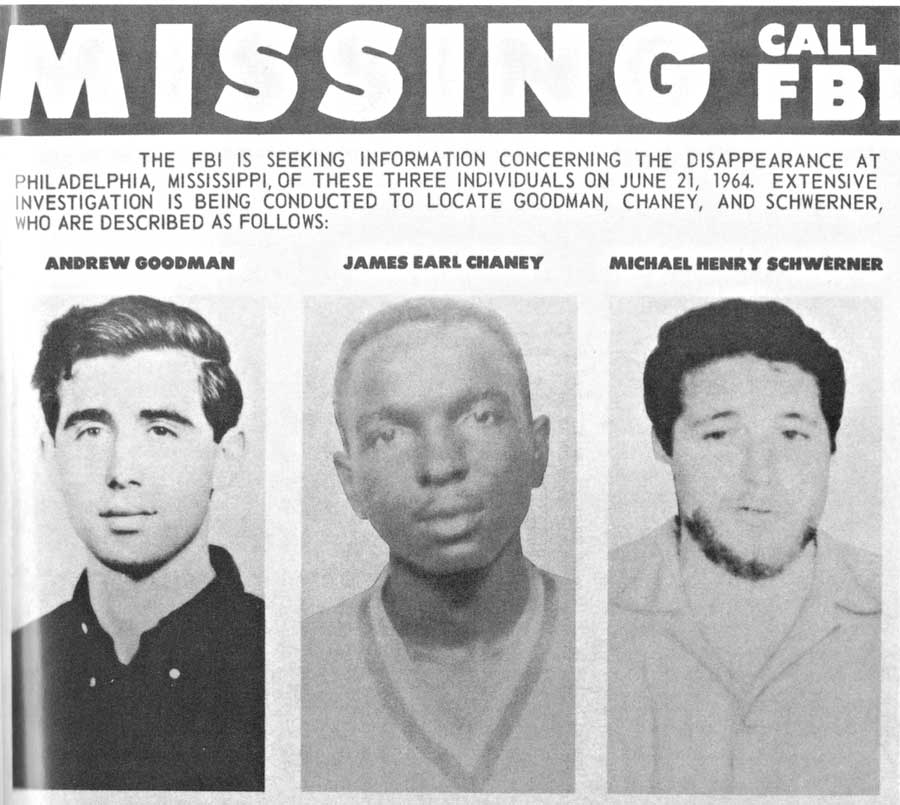 image
image
Found
On August 4, 1964, the bodies of Chaney, Schwerner and Goodman were found buried in an earthen damn on the property of Olen Burrage, a wealthy, local businessman.
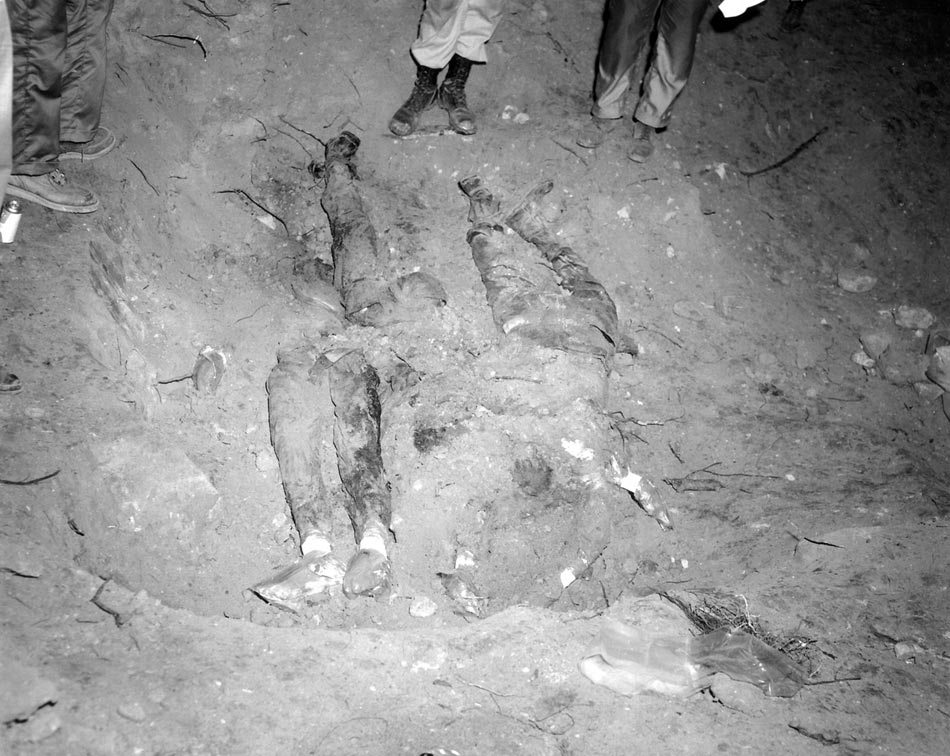 The civil rights workers were found dead in an earthen dam on land owned by Olen Burrage.
The civil rights workers were found dead in an earthen dam on land owned by Olen Burrage.
Most Suspects Dead
In 1964, the FBI accused 21 men, including Burrage, of taking part in the killings of Chaney, Schwerner and Goodman. State officials declined to prosecute any of the accused on murder charges. In 1967, a federal grand jury indicted 19 men on charges of conspiring to deprive the three civil rights workers of their civil rights. 1n 1967, 7 of those charged were found guilty of the lesser conspiracy charges.
On January 6, 2005, Klansman Edgar Ray Killen, was indicted on state murder charges and on June 21, 2005 was convicted on three counts of manslaughter. In 2005, besides Killen, 9 of the men who were charged in 1967 were still living.
Olen Burrage died this year at 84, never having been charged with murder. A few years earlier, Jerry Mitchell called Burrage on the phone.
When I called Burrage that day, it was in hopes of him answering that question: How could a bunch of Klansmen have slipped onto your property in the dead of night, run a bulldozer and buried three bodies 15 feet down without you hearing or knowing something?
I had hoped to ask Burrage that question, but what I heard instead was a click, followed by a dial tone.
A few days ago, Burrage died at age 84.
Now no one will ask him that question.
One living suspect remains, James Thomas “Pete” Harris, age 79. There is a strong case against him.
Coping and Remembering
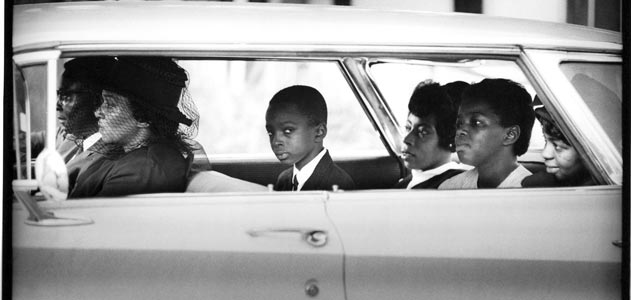 Ben Chaney and his parents and sisters en route to his brother James Chaney
Ben Chaney and his parents and sisters en route to his brother James Chaney
Hank Klibanoff tells the story of this photograph by Bill Eppridge.
On August 7, Eppridge watched as the Chaney family left to bury their eldest son. As they awaited a driver, Fannie Lee Chaney and her husband, Ben Sr., sat in the front seat of a sedan; their daughters, Barbara, Janice and Julia, sat in the back with Ben, who hunched forward so he’d fit.
Eppridge took three frames. As he did so, he could see Ben’s bewilderment harden into a cold stare directed right at the lens. “There were a dozen questions in that look,” Eppridge says. “As they left, he looked at me and said, three times, ‘I’m gonna kill ‘em, I’m gonna kill ‘em, I’m gonna kill ‘em.’ “
For victims’ families, coping with such anger and grief becomes a defining feature of their lives. In 2007, I spoke with Ben Chaney over the phone two days after his mother Fannie Lee Chaney was buried in Meridian, MS, next to her eldest son, James. I asked Ben how it felt knowing that she had died with most of the perpetrators never having been charged with murder.
I first met Ben Chaney in 2005 at the 41st annual memorial for Chaney, Goodman and Schwerner on the family land of the late Cornelius and Mable Steele who were local blacks working with James Chaney and Michael Schwerner on voter registration in Neshoba County, Miss.
Abiding Mysteries
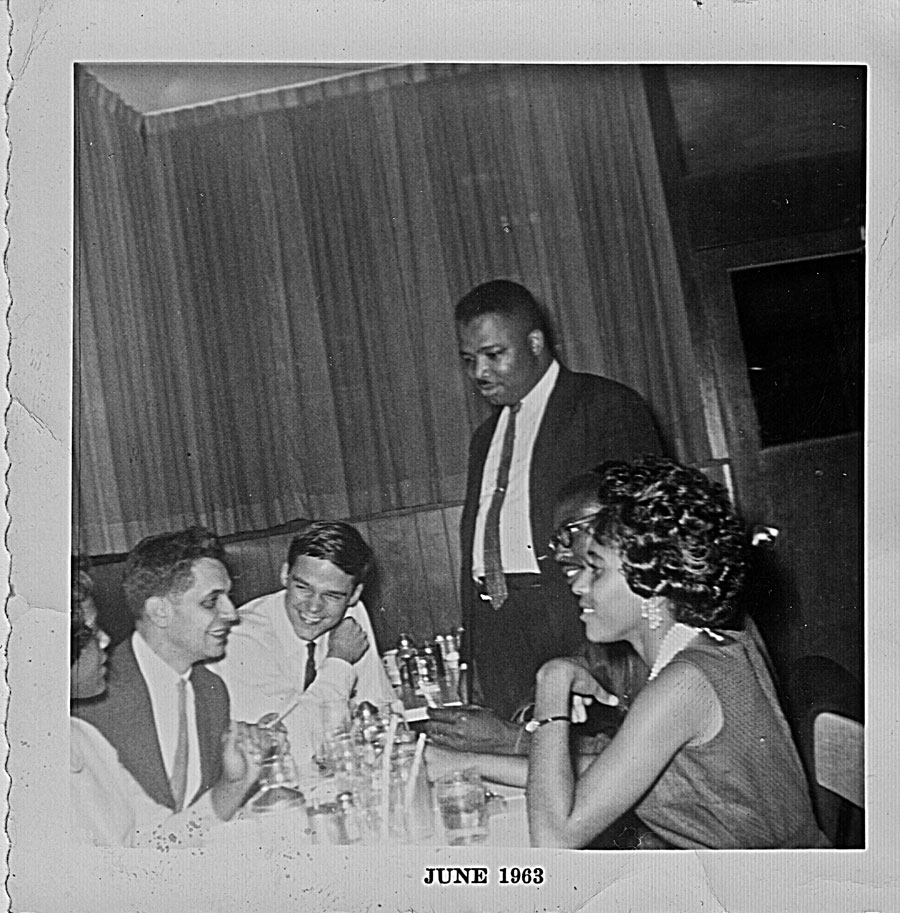 Paul Greenberg, AD King and others. Birmingham, AL, June, 1963
Paul Greenberg, AD King and others. Birmingham, AL, June, 1963
I started my other blog in 2004 to write about my dad’s involvement in the left generally and the Civil Rights Movement particular. I had no plan. In fact, the point of starting a blog was to write without a plan.
But as I got going, people started asking me if I was writing a book.
Something about driving to New York City to interview Dad’s political compatriots. Or about flying to San Francisco to (attempt to) interview a cantankerous, elderly jazz singer friend of Dad’s brotherly mentor, the late, great trumpeter Frankie Newton. Or about making dozens of FOIA requests and visiting archives.
I was a PhD student, after all. If I needed to know something, I researched.
I struck gold early on and got to see some bits of my dad’s life as civil rights activist in Birmingham materialize when my FOIAs turned up the Roosevelt Tatum story.
On Saturday morning, June 22, 1963, at around 9:00 a.m., A. D. King1 answered his front door and found Roosevelt Tatum. He was crying and saying he had something in his heart he wanted to tell. Tatum came inside and immediately noticed Paul Greenberg, the only white man among the dozen or more people in the house. Tatum had overcome his fear and wanted to say what he saw. When Tatum explained what he’d seen six weeks earlier, King asked him to talk to the FBI. Tatum agreed and King called the Birmingham FBI office to say that a man was at his home who saw persons responsible for the bombing.
When Agents Graybill and McFall arrived at the King residence, they found Tatum there, in the company of A. D. King, Paul Greenberg, and King’s secretary. The agents noticed alcohol on Tatum’s breath, and he explained that he’d had a couple of drinks for the nerve to tell what he saw. A. D. King explained that Roosevelt Tatum claimed to have seen two Birmingham Policemen in car 49 bomb the [AD and Naomi] King residence. Identifying himself as an employee of the Southern Christian Leadership Conference, Paul Greenberg interjected, wanting to know how soon publicity could be released. One of the agents replied, “the FBI is strictly a fact-finding agency; we are present solely for the purpose of obtaining the facts. Any premature publicity might only tend to jeopardize the investigation.” The Kings and Greenberg returned that they expected, in any case, to be present when Tatum would be interviewed.
I found the photo up top, of my father and AD King, more recently. It turned up just a few years ago, when my mom was packing up our 35-year family home in Delmar, NY to move to Delray Beach, FL.
June 1963 on the photo. How does it fit into the story? Was it before or after June 22? What was Dad doing there in Birmingham at the point when the photo was taken? What was he doing there at AD and Naomi King’s house before Tatum showed up on June 22? What establishment is that in the photo, with whites and blacks eating together? Who are the others in the photo besides Dad and AD King?
The energy of the scene seems to come from the interaction between Dad and the man with glasses. Look how engaged they are. What are they talking about? Why is AD King standing? Did he just get there? King seems slightly withdrawn, observing rather than participating, perhaps bemused by the scene or letting his mind wander to other things.
In 2005, I went to Alabama—my first time in the deep South. I visited SNCC veterans Scott B. Smith, Jr. and Linda Dehnad in Montgomery. Scott B took me to Selma and to the rural towns of Lowndes County, to the haunts from his days as one of the original Black Panthers with Stokely Carmichael in the Lowndes County Freedom Organization. You could say I helped establish Cleophus Hobbs Day.
 Scott B. Smith, Jr. looks out at the Edmund Pettus Bridge in Selma, AL. (Photo by Ben Greenberg.)
Scott B. Smith, Jr. looks out at the Edmund Pettus Bridge in Selma, AL. (Photo by Ben Greenberg.)
But I never went north to Birmingham. I went west to Mississippi.
By my fourth or fifth time back in Mississippi, it became clear that I was making a choice between the work I’d found there on civil rights cold cases and that unintentional book about my father.
I’m not giving up on the book about Dad, but time and resources for the work are limited—and both projects involve a shrinking window of opportunity to pursue living people with answers that will be lost to history once they die.
So for now, I focus on the project that I do because of him rather than the project that is about him.
- AD King (1930-1969) was the late, younger brother of Martin Luther King, Jr. and was also active in the Civil Rights Movement. ↩︎
June 19, 2013 dad paul greenberg mom new york florida photo hungryblues birmingham alabama ad king naomi king civil rights movement 1963 mississippi neshoba county scott b smith jr stokely carmichael black panthers linda dehnad cleophus hobbs roosevelt tatum photograph ekphrasis
I Am a Man
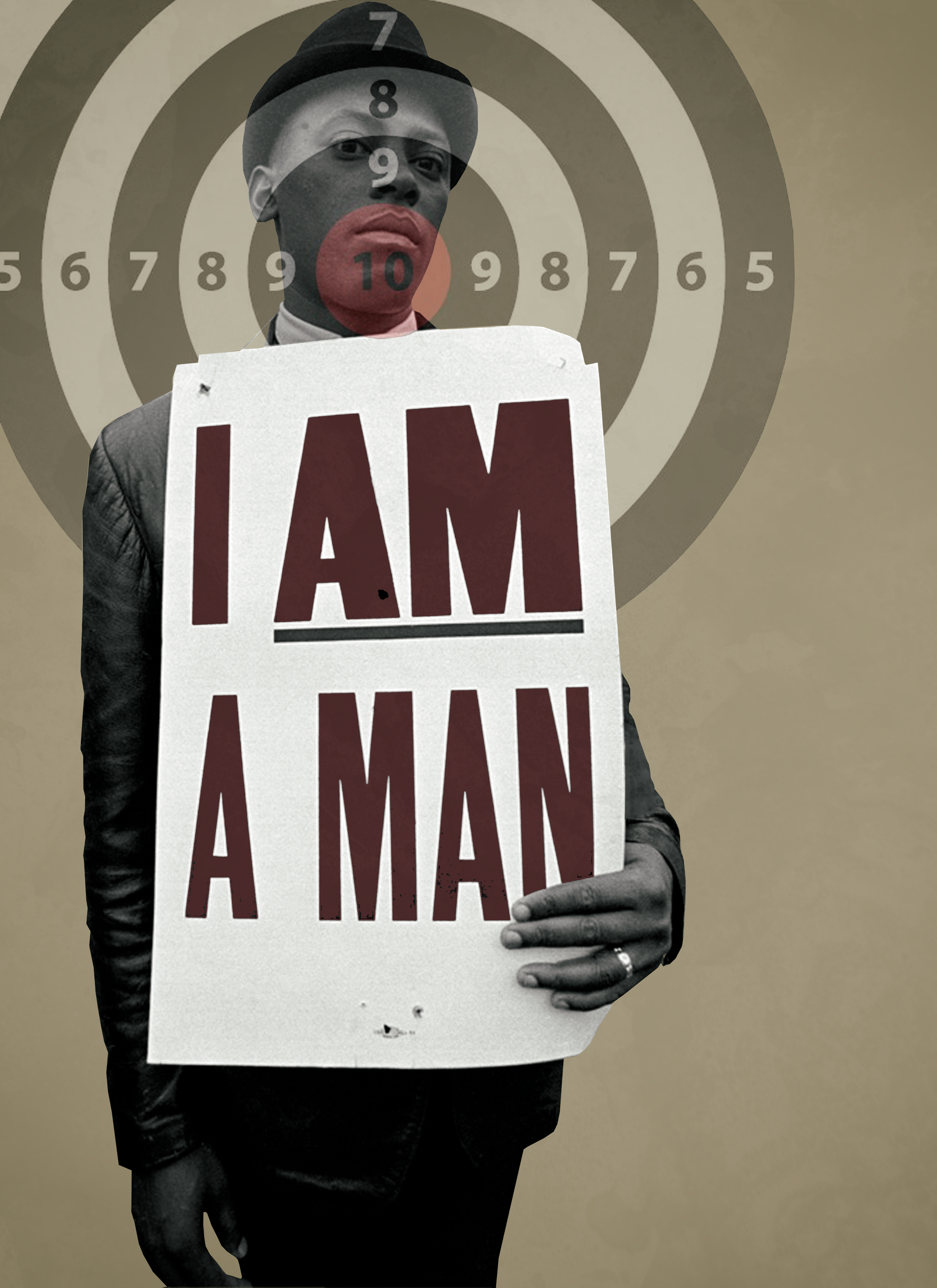
by Chip Thomas
May 14, 2012 black lives matter i am a man voting rights civil rights movement chip thomas

